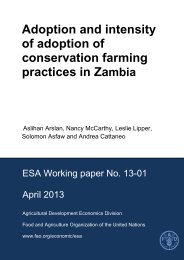Adoption and intensity of adoption of conservation farming practices in Zambia
Adoption and intensity of adoption of conservation farming practices in Zambia
Adoption and intensity of adoption of conservation farming practices in Zambia
You also want an ePaper? Increase the reach of your titles
YUMPU automatically turns print PDFs into web optimized ePapers that Google loves.
The coefficient <strong>of</strong> the agricultural wealth <strong>in</strong>dex is negative <strong>and</strong> significant, whereas that <strong>of</strong><br />
other wealth <strong>in</strong>dex is positive <strong>and</strong> significant. This suggests that while mostly households<br />
with little agricultural mach<strong>in</strong>ery adopt CF1 (keep<strong>in</strong>g <strong>in</strong> m<strong>in</strong>d that h<strong>and</strong> hoe is <strong>in</strong>cluded <strong>in</strong> the<br />
def<strong>in</strong>ition <strong>of</strong> CF1), otherwise better <strong>of</strong>f households with higher wealth <strong>in</strong>dices (i.e., more<br />
household durables) are more likely to adopt.<br />
Number <strong>of</strong> oxen owned is the only variable that is consistently significant: households with<br />
more oxen are significantly less likely to adopt CF <strong>in</strong> all specifications. Households <strong>in</strong> ASP<br />
districts are significantly less likely to adopt CF1, but this variable is not significant <strong>in</strong> all<br />
other specifications, fail<strong>in</strong>g to support the claim that ASP successfully promoted CF <strong>in</strong> the<br />
districts it operated <strong>in</strong>. The proportion <strong>of</strong> households <strong>in</strong> an SEA that received extension<br />
<strong>in</strong>formation on m<strong>in</strong>imum tillage significantly <strong>in</strong>creases the <strong>adoption</strong> <strong>of</strong> CF2 <strong>in</strong> the whole<br />
sample <strong>and</strong> CF1 <strong>in</strong> the Eastern prov<strong>in</strong>ce, underl<strong>in</strong><strong>in</strong>g the importance <strong>of</strong> extension <strong>in</strong><br />
promot<strong>in</strong>g <strong>adoption</strong>.<br />
We f<strong>in</strong>d that the higher the coefficient <strong>of</strong> variation <strong>of</strong> ra<strong>in</strong>fall <strong>in</strong> the district, the more likely<br />
that households will adopt CF <strong>in</strong> all specifications but CF1 <strong>in</strong> the whole sample. This<br />
supports the hypothesis that farmers perceive CF as a technology that can mitigate the effects<br />
<strong>of</strong> variable ra<strong>in</strong>fall <strong>and</strong> improve the efficiency <strong>of</strong> soil water management. Although we<br />
cannot establish directly that CF decreases the yield variability due to water stress over time,<br />
our f<strong>in</strong>d<strong>in</strong>g that <strong>adoption</strong> is significantly higher <strong>in</strong> areas <strong>of</strong> high ra<strong>in</strong>fall variability provides<br />
evidence for a synergy between CF <strong>and</strong> adaptation to climate variability. This f<strong>in</strong>d<strong>in</strong>g is<br />
strongly robust to various specifications.<br />
The probability <strong>of</strong> <strong>adoption</strong> for CF1 has significantly decreased between 2004 <strong>and</strong> 2008 <strong>in</strong><br />
the whole sample <strong>and</strong> the Eastern prov<strong>in</strong>ce as <strong>in</strong>dicated by the significant <strong>and</strong> negative<br />
coefficient on the 2008 dummy variable. This variable <strong>in</strong>dicates a similar trend <strong>in</strong> the<br />
<strong>adoption</strong> <strong>of</strong> CF2 <strong>in</strong> the whole sample, but an opposite trend <strong>in</strong> the Eastern prov<strong>in</strong>ce, where<br />
the probability <strong>of</strong> <strong>adoption</strong> <strong>of</strong> CF2 has <strong>in</strong>creased significantly between the two panels. The<br />
prov<strong>in</strong>cial dummy variables also show that households <strong>in</strong> the Eastern prov<strong>in</strong>ce are<br />
significantly more likely to adopt CF2 compared to households <strong>in</strong> the reference prov<strong>in</strong>ce <strong>of</strong><br />
Lusaka. These f<strong>in</strong>d<strong>in</strong>gs support our approach <strong>of</strong> model<strong>in</strong>g the Eastern prov<strong>in</strong>ce separately <strong>in</strong><br />
our analysis.<br />
5.2. Intensity <strong>of</strong> <strong>Adoption</strong><br />
Although most applied literature on CA tends to def<strong>in</strong>e <strong>adoption</strong> as a b<strong>in</strong>ary outcome (e.g.,<br />
hav<strong>in</strong>g some area under m<strong>in</strong>imum tillage), it has been accepted that <strong>adoption</strong> is not a b<strong>in</strong>ary<br />
process <strong>and</strong> tends to be partial <strong>and</strong> <strong>in</strong>cremental (Baudron et al. 2007; Umar et al. 2011). In<br />
this section, we present the results <strong>of</strong> our analysis <strong>of</strong> the <strong><strong>in</strong>tensity</strong> <strong>of</strong> <strong>adoption</strong> us<strong>in</strong>g the three<br />
different econometric models as described <strong>in</strong> section 4 above to ensure the consistency <strong>of</strong><br />
results.<br />
Interest<strong>in</strong>gly, most <strong>of</strong> the socio-economic variables that were not significant <strong>in</strong> determ<strong>in</strong><strong>in</strong>g<br />
<strong>adoption</strong> <strong>of</strong> CF1 are significant <strong>in</strong> determ<strong>in</strong><strong>in</strong>g the <strong><strong>in</strong>tensity</strong> <strong>of</strong> CF1 (Table 12). Household<br />
head’s age <strong>and</strong> average education significantly <strong>in</strong>crease the <strong><strong>in</strong>tensity</strong> <strong>of</strong> <strong>adoption</strong> <strong>in</strong> all<br />
specifications. Cultivated l<strong>and</strong> per capita decreases the <strong><strong>in</strong>tensity</strong> <strong>of</strong> <strong>adoption</strong>, <strong>in</strong>dicat<strong>in</strong>g that<br />
labor constra<strong>in</strong>ts play a role <strong>in</strong> farmers’ decisions on how much l<strong>and</strong> to allocate to CF1. The<br />
coefficient on the dependency ratio also supports this argument, though it is not significant <strong>in</strong><br />
the r<strong>and</strong>om effects tobit specification. Agricultural wealth <strong>in</strong>dex negatively affects the<br />
18



